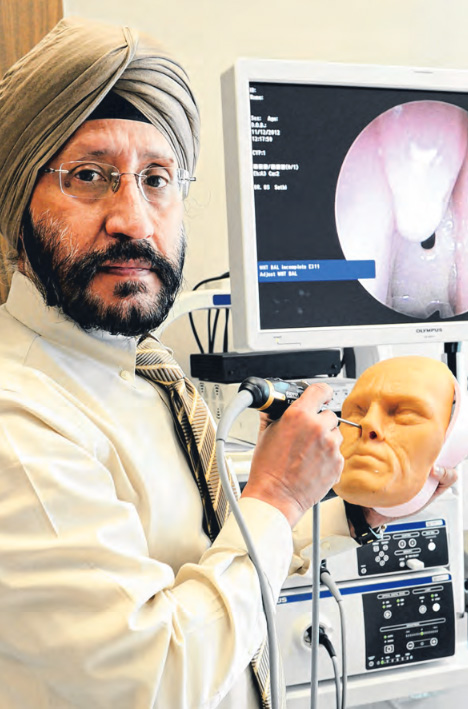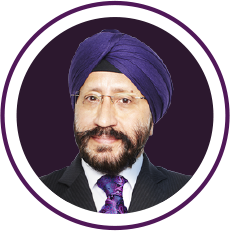Home / The Nose Mechanic
The Nose Mechanic
Call +65 8125 3580
for 24 by 7 appointment
Ear, nose and throat surgeon Dharambir Sethi tells Joan Chew why some people getnasal blockages during sex
I sub-specialise in diseases of the nose and sinus because...
In 1991, I attended an international meeting in Hong Kong where I heard a presentation by the pioneers in this field. It was right there and then that I decided to specialise in the area.
The nose and sinuses are fascinating because...
The nose is a thermostat as well as a filter.Regardless of the temperature of the air, the nose will ensure it is at body temperature by the time the air reaches the back of the nose.
The mucoid gel-like layer that lines the nasal cavity traps all pollutants and is then cleared via the throat.
Sinuses are air-filled cavities in the facial skeleton which extend from the forehead to almost the centre of the skull. To this day, no one is entirely sure of their exact function. But we use them for minimally invasive skull base surgery.
One little known fact about the nose is...
An area in the nose, called the inferior turbinate,has the same erectile tissue as the sexual organs.It is why some people get nasal blockages during intercourse. Recent research showed that the erectile tissue in the genitals and the nose are linked to the nervous system.
If I were to give an analogy for what I do, I would...
Be a mechanic or a software engineer.
Just as fuel needs to go through the pistons to get to the engine and keep the car running, oxygen needs to go through the nose and throat to get into the lungs to ensure that our bodies keep working.
A software engineer is concerned with the durability of his program so that there is little need for future upgrades. My work aims to ensure the same long-term capability.
Surgeons must be extremely precise and meticulous in all they do, to avoid making the smallest error that could corrupt the entire program.
A typical day for me would...
Have me wake up at 6am. I run a clinic every weekday except when operations are scheduled.Appointments start at 9am and last until 5 or5.30pm.
I hit the gym at least three times a week and run outdoors at least once a week – a routine I have kept to for my entire career except when I am travelling.
I usually spend weekends preparing for workshops and conferences which take place at least once a month. I also work towards meeting deadlines for book chapters and other publications.
I have come across all types of cases...
And treated almost every type found in a standard nose and sinus textbook.
Most patients come with nose allergies or sinus-related issues.
Tumours of the nose and sinuses may manifest as a runny nose or nasal blockage. These symptoms are often ignored by patients. By the time they see the doctor, the tumours, especially malignant ones, may have spread to the eyes and,maybe, the brain.

The brain is separated from the nose by a thin plate of bone called the skull base, through which the tumour can spread. A brain tumour may prolapse into the nose, looking like a mass in the nasal cavity.In addition, the orbits (eye sockets) are in close proximity to the nose, thus allowing for the possibility of infections and tumours of the nose and sinuses to extend into the eyes, risking the patient’s vision.
I love patients who...
Take things in their stride. It never ceases to amaze me how strong some people are.
I have been lucky enough to come across several patients who, despite hearing heart-rending news, maintain their composure and remain optimistic. Their positive attitude helps them cope with, overcome and survive the diseases.
Patients who get my goat are...
Overly demanding patients who are rude and abusive to nurses and paramedical staff.
Things that put a smile on my face are...
The look of gratitude on patients’ faces. Words of appreciation are not necessary, though patients do thank me for prolonging or improving the quality of their lives.
It breaks my heart when...
I have to inform patients that they have cancer and that it is inoperable.This is by far the hardest thing I have had to do and it does not get any easier with time.
I would not trade places for the world because...
I am lucky to be able to say that I have fulfilled most of my aspirations.When I was eight, I was fascinated with the idea of being a doctor. I bought a toy stethoscope,which I would secretly wear around my neck and stare at myself in the mirror, dreaming of the day that I would be called a doctor.If there was anything that I could have done differently, it would have been to spend more time with my family.
My best tip is...
Keep learning. What we knew five years ago has probably changed today, and what we know today may be irrelevant or wrong in another five years.
Dr Dharambir Sethi
AGE:59
OCCUPATION: Senior consultant ear, nose and throat (ENT) surgeonat Novena ENT – Head & NeckSurgery Specialist Centre
Dr Sethi believes in serendipity.One morning, after a night shift at the Singapore General Hospital(SGH) accident and emergency department, the then 26-year-oldmedical officer found himself in the lift with the head of the ENT department.Dr Sethi expressed his interest in the speciality. Not long after, he became a trainee doctor in the department.Four years later, he went on toget his specialist degree in theRoyal College of Surgeons in Edinburgh, Scotland.Another chance meeting in1992, this time with the chairman-of the ENT department at the Johns Hopkins Medical Institutions,brought him an opportunity to train at the United States hospital.He is now a visiting consultant at SGH, where he worked for33 years before leaving for private practice last November. He is also a clinical associate professor in otolaryngology at the Yong Loo Lin School of Medicine at the National University of Singapore. His wife, 54, works as a senior manager at Oracle Software in the US. His daughter, 29, is a lawyer in Paris, France, while his son, 22,recently graduated from Michigan State University in the US
